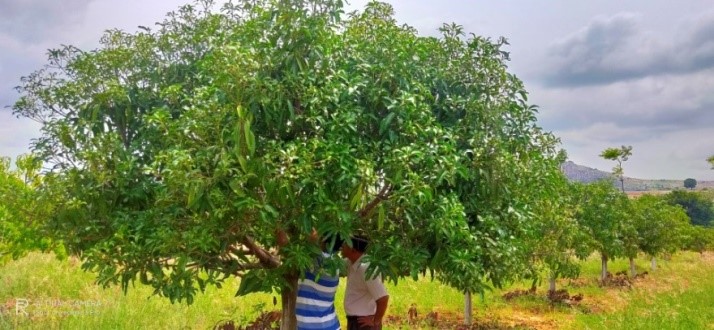
Bountiful harvest in Mango cultivation

Introduction:
In recent years mango cultivation has taken a back seat in crop preference in Karnataka, as only a few farmers are bold enough to cultivate mango crop in large areas. Though there are many reasons such as strong and hot winds, that affect flowering and fruit formation, heavy hailstorm and irregular rainfall, absence of proper marketing channels appears to be the main reason. But a farmer from Madhugiri taluk of Tumakuru district has a different story to tell. He is cultivating mango crop in 30 acres, but not satisfied with the performance. But, after the intervention of KVK, he is happy with the returns.
Background:
Sri.Sathyanarayana Reddy, aged 57, is a progressive farmer from Ayyanahalli village, Madhugiri taluk, Tumakuru District, Karnataka. He is educated, settled in Tumakuru, taking care of his 30 acres mango orchard, having Alphanso and Mallika varieties. Every year, there used to be heavy crop loss due to poor management practices that led to attack of pests like mango hoppers, fruit flies etc and diseases like powdery mildew and dieback. Initially, he used to spray insecticides by consulting other farmers and stake holders. But, there was no control over the pests and in due course, the tress were debilitating. The farmer was in search of suitable interventions and proper guidance for his mango dry land farming. Further, he used to apply blanket application of manures and fertilizers as well.
Interventions:
Technology:
During 2018-19, he came to know about the ICAR-Krishi Vigyan Kendra (KVK), Hirehalli (under IIHR) at Tumakuru and he contacted the Horticulture SMS. He visited his mango orchard and gave advice to go for integrated approach of good management practices by applying Enriched FYM with Arka Microbial Consortium @ 50 kg per tree and irrigation management etc. He also advised application of Mango special as foliar spray @ 5gm per litre of water @ 5 sprayers in a year to enhance the flowering, uniform mango size etc. Neem soap application @ 7 gm/litre of water was suggested to minimise the incidence of mango hoppers for every 8 days interval during flower initiation and at flowering. Installation of 10-15 Nos./ha fruit fly Pheromone traps for monitoring mango fruit flies and Arka Borer Control for management of stem borer were also advised.
Output and outcome:
In the year 2019-20, from the first bearing, he got a yield of 12,000 kgs in Alphonso and 29,604 kgs in Mallika variety. He could obtain a net profit of Rs.4,96,080 for the whole orchard (12 ha). During 2020-21 same interventions were followed and he got a yield of 13,240 kgs in Alphonso and 33,032 kgs in Mallika. He could obtain a net income of Rs. 5,96,040 from the 30 acres of Mango orchard.
Economic gains :
Before interventions, he used to get an income of Rs.21,380 per hectare only (Table 1). After the technical interventions from KVK, he found a good market due to quality produce. Sri.Sathyanarayana Reddy earned an income about Rs.45,505 per hectare by following the methodologies suggested by KVK (IIHR) for production and post-harvest care of mangoes.
Table 1. Economic analysis of a farmer’s returns before and after adoption of technology for mango crop
| Details | Yield
(q/ha ) | Gross Income
( Rs/ha) | Net Income
( Rs/ha) |
| Before Intervention | |||
| 2018-19 | 26.76 | 53520 | 21380 |
| Total returns for 12 ha | |||
| 297.12 | 642240 | 256560 | |
| After KVK Intervention | |||
| 2019-20 | 34.67 | 69340 | 41340 |
| 2020-21 | 38.56 | 77120 | 49670 |
| Mean Average | 36.62 | 73230 | 45505 |
| Total returns for 12 ha | |||
| 2019-20 | 416.04 | 832080 | 496080 |
| 2020-21 | 462.72 | 925440 | 596040 |
